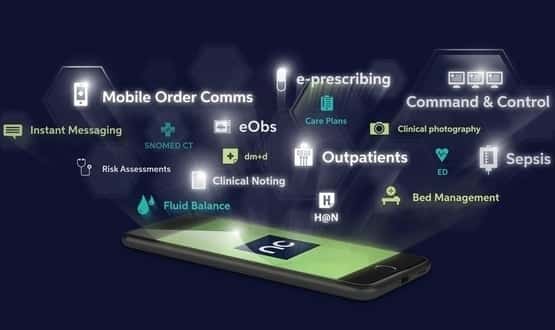Nervecentre EPR signals ‘fundamental shift’ in IT at Leicester trust
- 2 August 2019

The chief information officer at University Hospitals of Leicester NHS Trust has signified a ‘fundamental shift’ in IT provision as the organisation prepares to launch a mobile-first electronic patient record (EPR).
University Hospitals of Leicester, which is one of the largest acute trusts in England, will launch Nervecentre Software’s Next Generation EPR as part of its strategy of achieving HIMSS 7 certification.
The EPR will form the cornerstone of the trust’s efforts, which aims to consolidate existing clinical systems into a single patient record by 2022.
Andy Carruthers, acting CIO at Leicester’s Hospitals, told Digital Health News that implementation would “start immediately, beginning the implementation of mobile electronic prescribing and clinical noting in outpatients this year.”
Carruthers added: “Our approach to go live will be incremental, we have a three year programme of work planned which aims to take the trust to HIMMS level 7 by 2022.
“I am also pleased to note that this week NerveCentre have been accredited as an approved supplier on Lot 1 of the new Health Systems Support Framework. The development and implementation of interoperability standards will be a key part of our work in coming months.”
As part of a 10-year agreement, University Hospitals of Leicester will develop its existing Nervecentre capabilities with the addition of a mobile-first patient administration system, diagnostic requesting and e-prescribing. The trust also plans to develop the EPR to allow patients to interact with digital services and contribute to their health records.
Carruthers said the partnership with Nervecentre was “critical to our plans to improve record sharing across the region.”
“Our digital strategy is focused on how we can best use technology to provide better, safer and more efficient care for our patients – and maximise all the advantages of paperless working,” he added.
“The consolidated system will also give us better connectivity – and real-time visibility – with our partners in primary, community, mental health and social care.”
“This is a natural progression of our relationship with Nervecentre and marks a joint commitment to future-proof Leicester’s Hospitals so it can deliver sustainable services fit for the twenty first century.
“It signals a fundamental shift in our IT provision and is a key enabler for the organisation’s quality strategy. As we strive for digital maturity, the goal is to simplify our IT approach by building around a platform that’s mobile, modern and – crucially – well adopted by our staff. That’s why we chose Nervecentre.”
Nervecentre’s latest EPR was launched in June 2018, marketed as the first and only EPR system in the UK to be built from the ground-up for mobile devices.
Founder and CEO Paul Volkaerts suggested that, unlike traditional deployment strategies that prioritised administrative benefits, the deployment at University Hospitals of Leicester would be geared around placing patient safety at the forefront.
Volkaerts said: “Leicester’s Hospitals is already a strong user of Nervecentre’s Patient Safety feature set, and it is a tribute to the intuitive design of our mobile-first solutions that their clinicians wanted to build upon this mobile user experience for their EPR strategy.
“Leicester will be the first trust to follow our ‘PAS Last’ deployment strategy – focusing upon the key patient safety objectives of an EPR before focusing upon the administrative benefits – and this will form a blueprint for delivering HIMSS 7 compliance using a strategy that delivers value faster and at a lower total cost than traditional ‘big bang’ strategies.”
Carruthers added: “Creating a digital strategy for an ever-evolving function within a highly complex and changeable acute hospital environment is never easy. It’s important to get the foundations right and build flexible platforms that can adapt and respond as an organisation evolves.
“Our partnership with Nervecentre will play a pivotal part not only in setting those foundations but also in building on them to develop the world-class services our patients deserve. The opportunities for innovation are really exciting.”





2 Comments
Mobile has its place, but a full assessment of a patient cannot be carried out on a 5 inch screen. Mobiles are useful for that quick assessment on the way to see a patient for example, not day to day running and the full clinical record.
Workstations on wheels for example allow the clinician to involve the patient in their care on an easy to read screen and provide in depth analysis of the patient condition.
This approach has its risks for Leicester being a first of type going against the grain of worldwide digitisation.
Mobile must be the way to go now- desktop approach does not support clinical workflows- especially if we want to truly achieve Paper Free
Comments are closed.